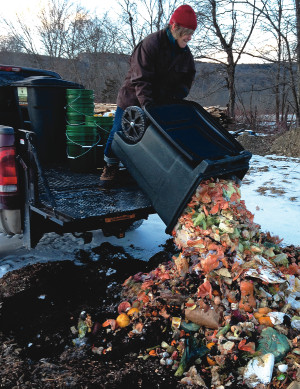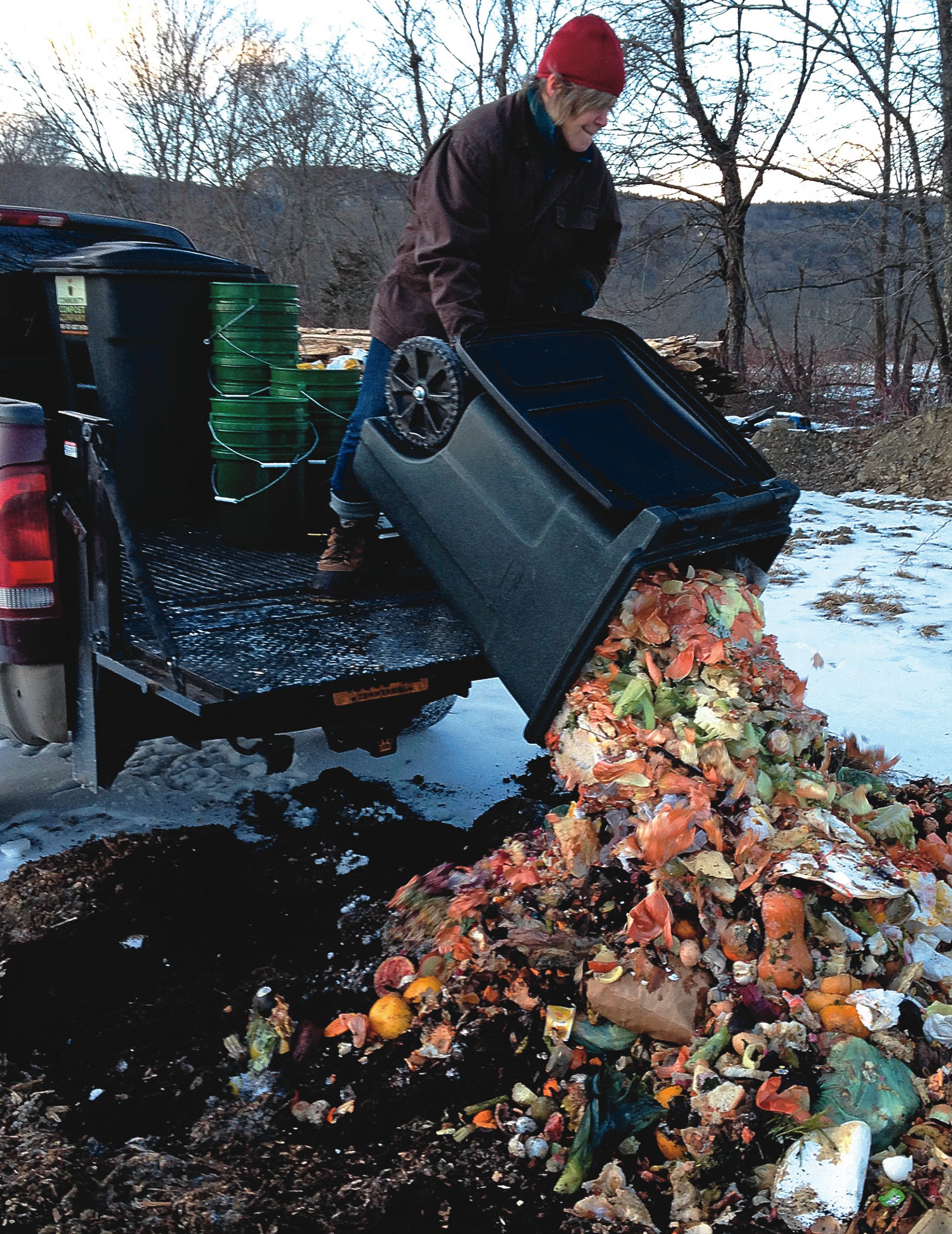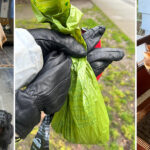BioCycle March/April 2015
Annapolis, Maryland: Food Waste Disposal Restrictions Proposed
Introduced in the Maryland legislature in February, Maryland House Bill 603, “Composting and Anaerobic Digestion Facilities — Yard Waste and Food Residuals,” calls for strengthening of an existing State of Maryland disposal ban on yard trimmings and for large food waste generators — only those that generate two or more tons per week per location — to divert these materials from disposal if recycling facilities with capacity exist within 40 miles. The bill also aims to reduce and recover food waste and to encourage rescue of edible food. It is a business-friendly bill, note proponents of the legislation. Food waste generators can reduce the amount of food waste disposed, cut their waste management costs, and divert materials instead to food rescue charities, farmers, composters and renewable energy/biogas facilities. Food waste recyclers in turn can sustain a new business sector, creating hundreds of new jobs in Maryland. The bill will stimulate investment in and expansion of needed capacity to handle recycling of food scraps and yard trimmings in Maryland. “It’s a great opportunity for Maryland to create jobs and products, reduce waste management costs, rescue edible food, and recycle the rest,” states HB 603’s sponsor, Delegate Shane Robinson.

For feedstock, Community Compost is already collecting food scraps from between 15 and 20 residential customers and 10 businesses in New Paltz, and 40 to 50 residential customers in Hoboken.
Cold Spring, New York: Farm Incubator Selects Composter For First Class
This spring marks the inaugural season for the Hudson Valley Farm Business Incubator, opened in October by Glynwood, an agricultural nonprofit. The 323-acre farm incubator is owned by the Open Space Institute in the Mohonk Preserve Foothills. And Community Compost Co., launched in New Paltz (NY) and Hoboken, New Jersey last May by co-owners Eileen Banyra and Noa Simons, will be one of the three fledgling businesses in its freshman class. “I had piloted a forced aeration system at Glynwood, and we were going to do the same at the incubator when I met Eileen, who was also interested in that,” explains Dave Llewellyn, Glynwood’s director of farmer training. “It became a good idea to consider piloting their business on the property.” Banyra, an environmental planner, had teamed with Simons, an investment company partner and local farmer, to develop her new model for the composting business. “Looking at the many initiatives with food and farming in the Hudson Valley, no composting was being done on any scale,” notes Banyra, who had visited Simons on her New Paltz farm while seeking composting sites.
By using the incubator as its primary production site and partnering with multiple farm owners for more sites, Banyra and Simons expect to substantially reduce their capital costs. In lieu of rent for the land, utilities and shared equipment, the incubator and partner farms get a share of the compost, and the company manages the site. It is already managing an aerated static pile at Four Winds Farm, an organic farm in Gardiner (NY). The incubator site is permitted, but not fully operational. “We’ve just been permitted to power the blowers on timers with solar panels, and we put in a shale pad, as we have a shale pit on the property,” says Llewellyn.
As the incubator site is not a commercial facility, Community Compost is allowed to take up to 1,000 cubic yards of food scraps and an unlimited amount of manure and/or woody materials, adds Banyra. Full-scale compost production is planned for early spring. For feedstock, Community Compost is already collecting food scraps from between 15 and 20 residential customers and 10 businesses in New Paltz, and 40 to 50 residential customers in Hoboken, where Banyra has worked as a planner. “We just started door-to-door collection in Hoboken and hope to partner with the city, as the mayor is very big on environmental initiatives,” she notes. The company’s first-year goal is 400 residential customers and 20 commercial customers, with a total production of 1,000 cubic yards of finished compost.
Austin, Texas: Estimated Organics Recycling Rate
The Texas Recycling Data Initiative (TRDI) is a collaboration to measure recycling in the state of Texas, initiated by a consortium of many stakeholders — including private industry, governmental agencies and nonprofit organizations — and led by a partnership between the State of Texas Alliance for Recycling (STAR) and the Lone Star Chapter of the Solid Waste Association of North America (TxSWANA). TRDI undertook a voluntary survey to update Texas’ recycling data. Findings were released in February 2015. The survey focused on quantifying the amount of material recycled from homes, businesses and institutions, like schools and hospitals. TRDI chose a few recycled materials from the manufacturing sector to include in the survey. Texas-based recyclers were targeted to participate, including recyclers of traditional recyclables (paper, plastic, glass and metal), organic materials (yard waste, food waste and biosolids), and other materials (construction materials, household hazardous waste, electronics, textiles and tires).
A total of 13,919,817 tons of Texas material was recycled in 2013 (and probably more, since TRDI notes it was being conservative). Of the total, 6,143,393 tons came from homes, businesses and institutions (rather than manufacturing), representing 18.9 percent of the more than 32 million tons of waste generated by Texas homes, businesses and institutions in 2013. Yard trimmings, brush and green waste comprised about 970,000 tons (about 16% of the 6.1 million tons recycled); food and beverage materials accounted for about 20,000 tons (<1% of the total). Based on available data, households with curbside recycling generate an average of 503 lbs/year of recyclables. Finally, TRDI estimates that 12,678 Texas jobs are supported by materials recycled from homes, businesses and institutions (and it states that this number is intentionally conservative).
Snohomish County, Washington: Crop Trials Evaluate Compost Use, Yields
The Washington State University (WSU) Snohomish County Extension’s Compost Outreach Project provides Snohomish and King County farmers with an opportunity to see first-hand the benefits of incorporating compost into their cropping systems. Its on-farm research is helping document the value of using compost in local cropping systems, and in the process, create a sustainable system for returning urban landscape and food waste to local farms. In 2014, 50 farms were participating in the project.
An article in the November 14, 2014 Whatcom Ag Monthly by Andrew Corbin and Hallie Harness with WSU Snohomish County Extension and Leif Fixen with the Snohomish Conservation District — “Compost Outreach Project, Improving Yields and Soil Quality” — describes compost trial results at three farms. Summaries of the findings include:
Carelton Farm’s 2014 Pickling Cucumber Trial: Pickling cucumbers are the second most profitable crop grown (the farm experienced increased yields on pumpkins, its most profitable crop, following compost application). The research plots had previously received compost and soil samples revealed that no additional macronutrients were needed. “Compost treatment averages resulted in 2.55 additional tons/acre of marketable cucumbers (pickles and slices) compared to the control,” notes the article. “At $1.30/lb, an additional $6,630/acre of gross profit is possible.” Expenses such as compost, additional labor, fuel and equipment needed for spreading were not subtracted.
Williams Farm’s 2014 Beet Seed Trial: Report the authors: “Compost was applied directly after planting the beets at a rate of about 55 cubic yards (cy)/acre. … The compost application resulted in a 21 percent increase in beet seed yield compared to the control. At $1.50/lb, this increase in yield equates to a $262.88/acre gross increase in profit. At the 55 cy/acre application rate and including spreading expenses, the breakeven point is $4.80/cy of compost delivered and applied.”
Darrell Hagerty 2014 Organic Green Beans Trial: Certified organic compost from Lenz Enterprises in Stanwood, Washington made it possible to conduct a 2014 compost research trial on the farm’s organic green beans. Continues the article: “Darrell utilizes chicken manure, cover cropping, wood ash, organic fertilizers and reduced tillage practices to maintain fertility [‘business as usual’ or BAU] and this trial has provided the opportunity to utilize food and yard waste compost as an experimental input.”
Compost was applied at a rate of about 24.8 cy/acre (about 6.5 dry tons/acre). Organic green beans were planted two days later. Pelleted chicken manure and Nutra-rich fertilizer were applied across all plots. “Compost resulted in a statistically significant 19 percent (0.64 tons/acre) increase in yield compared to the BAU treatment. At $485/ton of green beans, this increase translates to a $312/acre gross increase in profit. Including spreading expenses, the breakeven point is $12.58/cy of compost, delivered and applied.”
Determining the breakeven point is important as it can assist in pricing compost for use in these agricultural applications. Other compost use benefits reported by participating farmers (and not factored into cost-benefit calculations) are increased soil organic matter and plant-available nitrogen; decreased plant stress during dry, hot months; weed suppression due to rapid plant establishment; increased water retention; and improved soil tilth and workability. The Whatcom Ag Monthly article can be downloaded via the online version of this item. Harness and Corbin will be presenting their research findings at the BioCycle West Coast Conference in Portland on April 15 (view agenda at www.biocyclewestcoast.com).
Westerville, Ohio: Use Of Biochar In Composting
A research summary prepared by the International Biochar Initiative (IBI) highlights potential benefits of incorporating biochar into composting. Biochar is a solid material obtained from the thermochemical conversion of biomass in an oxygen‐limited environment. Based on current findings, the benefits of adding biochar to the composting process may include shorter composting times; reduced rates of greenhouse gas emissions (methane and nitrous oxide); reduced ammonia losses; ability to serve as a bulking agent for composting; and reduced odor, states IBI’s publication, “The Use of BioChar In Composting.” It adds that for the biochar material itself, “undergoing composting helps to charge the biochar with nutrients without breaking down the biochar substance in the process.” The following are excerpts from the research summary:
• A biochar dose higher than 20 to 30 percent (mass basis) is not recommended as an excessive amount relative to the composting material could interfere with biodegradation.
• Adding biochar at 3 percent (mass basis) to a pig manure, wood chips and sawdust composting mixture was found to reduce nitrous oxide emissions by 26 percent. A recent study found that the addition of biochar reduced methane emissions from poultry manure composting piles.
• A 20 percent (mass basis) biochar addition to poultry litter composting reduced the ammonia concentration in the emissions by up to 64 percent and nitrogen losses by up to 52 percent without negatively influencing the process.
More information is available at www.biochar-international.org














